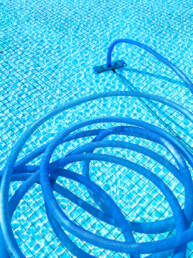As the warm days of summer fade into the crispness of fall and the chill of winter approaches, it’s crucial to prepare your pool for the seasonal changes. Proper winterization not only protects your investment but also ensures your pool is ready for use when the warmer months return. Here’s a comprehensive guide from Laguna Pools to help you get your pool ready for fall and winter.
Clean the Pool Thoroughly
Cleaning your pool before closing it for the season is a crucial step to ensure its longevity and maintain its condition. Here’s a detailed guide to help you achieve a spotless pool:
Skim the Surface
Start by using a skimmer net to remove leaves, twigs, and other debris floating on the surface of the water. This step is important because debris left on the water can decompose and lead to staining or algae growth. Regular skimming also prevents debris from sinking to the bottom or clogging the pool’s filtration system.
Brush the Pool
Next, use a pool brush to scrub the walls and floor of your pool. Focus on areas where dirt and algae are likely to accumulate, such as corners and steps. Brushing helps loosen dirt, algae, and other contaminants that may have settled on the surfaces. For pools with vinyl liners, use a brush with soft bristles to avoid damaging the material. For plaster or fiberglass pools, a stiffer brush may be necessary to effectively remove stains and build-up.
Vacuum the Pool
After brushing, vacuum the pool to remove the loosened debris and dirt. Depending on your pool setup, you can use either a manual vacuum or an automatic pool cleaner. Manual vacuums require you to connect a vacuum head to a telescoping pole and manually clean the pool, while automatic cleaners move around the pool autonomously. Vacuuming ensures that all the debris and dirt that was loosened by brushing are removed from the pool, leaving the water clear and clean.
Clean the Skimmer and Pump Baskets
While cleaning the pool, don’t forget to check and empty the skimmer and pump baskets. These baskets collect debris that could clog the filtration system if left unchecked. Emptying them ensures that water flows efficiently through the filter system and helps prevent potential issues with water circulation.
Check and Clean the Filter
Inspect the pool filter to ensure it’s clean and functioning properly. If you have a cartridge filter, remove and clean the cartridge according to the manufacturer’s instructions. For sand filters, backwash the system to clear out any trapped debris. A clean filter is essential for maintaining water quality and preventing contamination.
Address Algae Growth
If you notice any signs of algae growth, treat it before closing your pool. Algae can quickly spread if not addressed, and it’s easier to tackle when the pool is open. Use an algaecide or pool shock treatment to eliminate algae and prevent it from becoming a larger problem over the winter.
Check Water Levels
Ensure that the water level is appropriate before closing the pool. The water should be below the skimmer but above the bottom drain to prevent freeze damage. If necessary, adjust the water level to ensure proper coverage and protection.
Remove Any Additional Debris
Lastly, take the time to remove any remaining debris from the pool deck and surrounding area. Cleaning the area around the pool prevents dirt and leaves from blowing into the pool and keeps your pool environment tidy.
By taking these comprehensive steps to clean your pool, you’ll help prevent staining, algae growth, and other issues that can arise over the winter months. A clean pool not only looks better but also reduces the amount of work needed when you reopen it in the spring.
Balance the Water Chemistry
Maintaining proper water chemistry is crucial for protecting your pool during the off-season and ensuring it remains in top condition when you reopen it. Here’s how to achieve balanced water chemistry:
Test the Water
Start by testing the water using a pool water testing kit or digital tester. This will measure the key parameters: pH, alkalinity, and calcium hardness. Regular testing ensures that all these levels are within the recommended ranges.
Adjust the pH
The pH level measures the acidity or alkalinity of the water. Ideally, your pool’s pH should be between 7.4 and 7.6. If the pH is too high (alkaline), it can lead to scale formation on pool surfaces and equipment. If it’s too low (acidic), it can cause corrosion and damage to pool components. Use pH increaser (sodium carbonate) to raise the pH if it’s too low or pH decreaser (sodium bisulfate) to lower it if it’s too high. Follow the manufacturer’s instructions for the correct dosage and allow the water to circulate for several hours before retesting.
Adjust the Alkalinity
Total alkalinity helps stabilize the pH level and prevents it from fluctuating. The recommended range for total alkalinity is 80-120 parts per million (ppm). If the alkalinity is too low, it can lead to pH fluctuations and surface damage. If it’s too high, it can make it difficult to adjust the pH and lead to cloudy water. Use alkalinity increaser (sodium bicarbonate) to raise alkalinity or acid (muriatic acid or sulfuric acid) to lower it. Again, follow the product instructions and allow the water to circulate before retesting.
Adjust the Calcium Hardness
Calcium hardness measures the amount of dissolved calcium in the water. The ideal range is 200-400 ppm. Low calcium hardness can cause the pool water to become corrosive, leading to damage to pool surfaces and equipment. High calcium hardness can lead to scale buildup and cloudy water. To increase calcium hardness, use a calcium hardness increaser. If it’s too high, you may need to partially drain and refill the pool with fresh water to dilute the calcium concentration.
Monitor and Maintain
Once the water chemistry is balanced, it’s important to periodically check the levels throughout the off-season, especially if there are any significant weather changes. This helps ensure that the water remains stable and prevents any issues that could arise from imbalanced chemistry.
Shock the Pool
Shocking your pool is an essential step to ensure the water remains clean and free of contaminants over the winter. Here’s a detailed guide on how to shock your pool effectively:
Understand Pool Shocking
Shocking involves adding a high dose of chlorine or a non-chlorine shock treatment to the pool water. This process helps to oxidize and eliminate organic contaminants such as bacteria, algae, and chloramines (combined chlorine). Shocking ensures that the water remains sanitized and clear while the pool is closed.
Choose the Right Shock Treatment
There are two main types of shock treatments: chlorine-based and non-chlorine (oxidizing) shock. Chlorine-based shock (calcium hypochlorite) is highly effective and usually recommended for severe contamination. Non-chlorine shock (potassium peroxymonosulfate) is less harsh and suitable for routine maintenance or as a follow-up to a chlorine shock. Choose the type that best suits your pool’s needs and follow the manufacturer’s instructions for application.
Apply the Shock Treatment
To shock the pool, first, ensure the pool pump and filter are running. This helps distribute the shock treatment evenly throughout the pool. If using a granular chlorine shock, dissolve the granules in a bucket of water before adding them to the pool to prevent cloudiness and potential damage to the pool surface. For liquid shock, pour it directly into the pool. Spread the shock treatment evenly around the pool, focusing on areas with heavy debris or visible contamination.
Allow the Shock to Work
After applying the shock treatment, let the pool circulate for several hours, as recommended by the product instructions. Avoid swimming in the pool until the chlorine levels have returned to safe levels, typically indicated by a chlorine test kit. It’s important to allow sufficient time for the shock treatment to kill bacteria and oxidize contaminants before reopening the pool.
Monitor and Test
After shocking the pool, test the water to ensure the chlorine levels have returned to a safe range before allowing anyone to swim. Regularly monitor the water chemistry and perform additional shocking as needed, especially if you notice any issues with water clarity or contamination.
By thoroughly balancing your pool’s water chemistry and properly shocking it, you help ensure that your pool remains in excellent condition throughout the winter months. These steps minimize potential issues and make the process of reopening your pool in the spring much smoother.
Remove and Store Accessories
Removing and storing pool accessories is an important step in preparing your pool for the winter. Here’s a detailed approach:
Remove Accessories
Start by removing all pool accessories, including:
- Ladders and Steps: Detach the ladder or steps from the pool and remove them. These can be prone to rust and deterioration if left exposed to the elements.
- Diving Boards: If your pool has a diving board, remove it carefully. Diving boards can be damaged by freezing temperatures and harsh weather conditions.
- Skimmers and Brushes: Take out any skimmers, brushes, and other cleaning tools. These items should be cleaned and stored properly to prevent wear and tear.
- Pool Covers: If you use a mesh or safety cover, remove it for cleaning and storage.
Clean and Dry Accessories
Thoroughly clean all removed accessories. For ladders and diving boards, scrub away any algae, dirt, or debris. Rinse them with clean water to remove any residual chemicals or contaminants. For skimmers and brushes, wash them with mild soap and water to ensure they are free of dirt and chemical residues.
After cleaning, dry all accessories completely. Ensure that no moisture is left, as water left on these items can freeze and cause damage.
Store Accessories
Store cleaned and dried accessories in a dry, sheltered area. This could be a shed, garage, or any other enclosed space that will protect them from moisture and extreme temperatures. Avoid leaving them outside where they can be exposed to freezing conditions or harsh weather.
Inspect for Damage
Before storing, inspect each accessory for any damage or wear that may need to be addressed. Repair or replace any damaged items before you need to use them again.
Drain the Water
Draining the pool properly is crucial to prevent freeze damage and maintain the pool’s condition. Follow these steps:
Lower the Water Level
Reduce the water level to just below the skimmer. This helps prevent freeze damage to the skimmer and other components. For vinyl liner pools, lowering the water level too much can cause the liner to shrink, so consult your pool professional for specific recommendations based on your pool type.
Drain the Equipment
Carefully drain the water from all pool equipment, including:
- Pump: Remove the drain plugs from the pump and let all water drain out. If your pump has a drain valve, open it to ensure all water is expelled.
- Filter: Remove the filter from the pool system and open any drain plugs or valves to empty it completely. For sand filters, backwash the system to clear out debris before draining.
- Heater: If your pool has a heater, drain it according to the manufacturer’s instructions. This usually involves removing drain plugs or valves to prevent water from freezing inside the heater.
Remove Water from Lines
Use a shop vac or air blower to remove any remaining water from the pool’s plumbing lines. This step is crucial to prevent freezing and potential pipe damage. Blow air through the lines to clear out any trapped water, and ensure that all lines are completely dry.
Check for Proper Drainage
Inspect all drain plugs and valves to ensure they are securely closed after draining. This helps prevent debris from entering the equipment and keeps the system in good condition.
Add Winterizing Chemicals
Adding winterizing chemicals helps protect your pool and keep it in good condition through the off-season. Here’s how to effectively use them:
Choose Winterizing Chemicals
Winterizing chemicals are designed to maintain water balance and prevent issues such as algae growth and scale formation. Common winterizing products include:
- Algaecide: Helps prevent algae growth during the winter months. Choose an algaecide that is suitable for your pool type and follow the recommended dosage.
- Winterizing Kits: These kits often include a combination of algaecide, enzyme products, and other chemicals to stabilize the water. Winterizing kits provide a comprehensive approach to pool care over the winter.
- Stabilizer or Conditioner: If your pool has a high level of cyanuric acid (a stabilizer), consider adding a stabilizer product to help maintain proper chlorine levels.
Add Chemicals
Follow the manufacturer’s instructions for adding winterizing chemicals to your pool. Typically, this involves:
- Pouring chemicals directly into the pool while the pump is running to ensure even distribution.
- Adjusting the water chemistry before adding winterizing chemicals to ensure that all levels are balanced. This helps the chemicals work more effectively.
Circulate the Water
Allow the pool’s filtration system to run for a few hours after adding winterizing chemicals. This ensures that the chemicals are thoroughly mixed and distributed throughout the pool.
Monitor and Adjust
Monitor the water chemistry periodically throughout the winter. If necessary, make adjustments to ensure the water remains balanced and free of contaminants.
By thoroughly addressing these steps, you’ll help ensure that your pool remains in excellent condition throughout the fall and winter months. Proper preparation not only protects your investment but also makes the process of reopening your pool in the spring much easier and more efficient.
Cover the Pool
Invest in a high-quality pool cover that fits your pool perfectly. A good cover helps keep debris out, reduces the risk of damage, and minimizes water evaporation. Make sure the cover is securely fastened and free of any gaps where leaves or animals could get in.
Conclusion
Properly preparing your pool for fall and winter is key to protecting your investment and ensuring a smooth reopening when the weather warms up. By following these steps and seeking professional assistance from Laguna Pools, you can enjoy a hassle-free winter and be ready to dive back into your pool come spring. If you have any questions or need help with winterizing your pool, don’t hesitate to contact Laguna Pools for expert advice and service.

Ready for an expert opinion? Get in touch today!
Laguna Pools is a professional pool and spa contractor that has been servicing the Denver area for over 20 years. We offer routine cleaning and maintenance services, new pool design, construction, and remodeling.
Like this article? Spread the word!
Related Posts
February 10, 2025
Laguna Pools: Denver’s Trusted Pool Builder & Expert Pool & Spa Maintenance Team
Keep your pool in perfect condition year-round with Laguna Pools. From custom pool…
December 20, 2024
Top 10 Trends in Pool Design for 2025
Discover the top 10 pool design trends for 2025, from smart technology to natural pools.…
November 15, 2024
Why You Shouldn’t Neglect Pool Maintenance in Winter: Save Time and Money on Repairs with Laguna Pools
Ensure your pool stays in top shape this winter with expert maintenance from Laguna…





